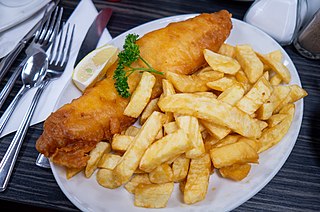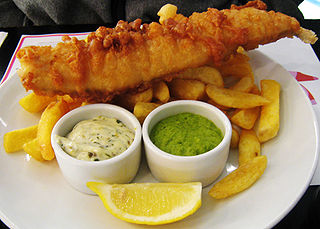Spam is a brand of salty processed canned pork made by Hormel Foods Corporation. It was introduced by Hormel in 1937 and gained popularity worldwide after its use during World War II. By 2003, Spam was sold in 41 countries on six continents. In the U.S., Hawaii is the state with the highest per capita consumption of Spam, which has become an ingredient in Hawaiian cuisine.

Fish and chips is a hot dish consisting of fried fish in batter, served with chips. The dish originated in England, where these two components had been introduced from separate immigrant cultures; it is not known who combined them. Often considered Britain's national dish, fish and chips is a common takeaway food in numerous other countries, particularly English-speaking and Commonwealth nations.

Cornmeal is a meal ground from dried corn. It is a common staple food, and is ground to coarse, medium, and fine consistencies, but not as fine as wheat flour can be. In Mexico, very finely ground cornmeal is referred to as corn flour. When fine cornmeal is made from maize that has been soaked in an alkaline solution, e.g., limewater, it is called masa harina, which is used for making arepas, tamales and tortillas. Boiled cornmeal is called polenta in Italy and is also a traditional dish and bread substitute in Romania.

The black-eyed pea or black-eyed bean is a legume grown around the world for its medium-sized, edible bean. It is a subspecies of the cowpea, an Old World plant domesticated in Africa, and is sometimes simply called a cowpea.

Mushy peas are dried marrowfat peas which are first soaked overnight in water with sodium bicarbonate, and then rinsed in fresh water, after which the peas are gathered in a saucepan, covered with water, and brought to a boil, and then simmered until the peas are softened. The mush is seasoned with salt and pepper.

A fritter is a portion of meat, seafood, fruit, vegetables or other ingredients which have been battered or breaded, or just a portion of dough without further ingredients, that is deep-fried. Fritters are prepared in both sweet and savory varieties.

The term "Chicken Maryland" or "Maryland Chicken" refers to a historic dish associated with the U.S. state of Maryland, but has other meanings from other nations. In its home base, the food dish consists of fried chicken served with a cream gravy. It is traditionally garnished with bananas, which were historically one of Baltimore's leading imports.

A fish and chip shop, sometimes referred to as a chip shop, is a restaurant that specialises in selling fish and chips. Usually, fish and chip shops provide takeaway service, although some have seating facilities. Fish and chip shops may also sell other foods, including variations on their core offering such as battered sausage and burgers, to regional cuisine such as Greek or Indian food.
Potato cake is a name given to various shaped potato dishes around the world, including a patty of hashed potatoes, a fried patty of mashed potato, a fried and battered slice of potato, or a flatbread made with mashed potato and flour. In some states in Australia a thin slice of potato that is battered and deep fried may be called a potato scallop, potato cake or potato fritter.

Burmese tofu is a food of Shan origin, made from water and flour ground from yellow split peas and the Burmese version of chickpea flour, also known as besan flour, in a fashion similar to polenta. The flour is mixed with water, turmeric, and a little salt and heated, stirring constantly, until it reaches a creamy consistency. It is then transferred into a tray and allowed to set. It can also be made using dried chickpea instead of processed flour. In this process, dried chickpeas are soaked overnight. Once the peas have been re-hydrated, they are ground into a puree with some of the liquid used to soak the peas, then allowed to set for a couple of hours. Much of the top layer of clear liquid is then skimmed off and the remaining puree is brought to a boil with turmeric and salt and cooked and set in the same manner as the version using chickpea flour. It is matte yellow in colour, jelly-like but firm in consistency, and does not crumble when cut or sliced. It may be eaten fresh as a Burmese tofu salad or deep-fried into a Burmese fritter. It may also be sliced and dried to make crackers for deep frying. Despite the name, Burmese tofu is unrelated to Chinese tofu, which is made from soy milk with added coagulants.

Fried plantain is a dish cooked wherever plantains grow, from West Africa to East Africa as well as Central America, the tropical region of northern South America and the Caribbean countries like Haiti to Cuba and in many parts of Southeast Asia, where fried snacks are widely popular. In Indonesia it is called gorengan. It is called alloco in Côte d'Ivoire and dodo in Western Nigeria, otherwise known as simply fried plantain in other parts of Nigeria. Kelewele is a fried spicy plantain or can be fried as a side dish for Red Red and fish stew in Ghana.

A banana fritter is a fritter made by deep frying battered banana or plantain in hot oil. It is a common dish across Southeast Asia and South India.

Perkedel are vegetable fritters from Indonesian cuisine. Most common perkedel are made from mashed potatoes, yet there are other popular variants which includes perkedel jagung and perkedel tahu and perkedel ikan. Throughout most of Indonesia it is called perkedel; however, it is called begedil in Javanese, and also called that way in Malaysia and Singapore, which could suggest that this fried food was introduced by Javanese immigrants to Malaysia and Singapore.

Burmese fritters are traditional fritters consisting of vegetables or seafood that have been battered and deep-fried. Assorted fritters are called a-kyaw-sone. Burmese fritters are generally savory, and often use beans and pulses, similar to South Asian vada.

Batterfish is a fish and chip shop in Portland, Oregon. Previously, the business operated in Encino, Los Angeles, as a food truck in Santa Monica, California, and as a food cart in Happy Valley, Oregon. Batterfish specializes in fish and chips and has been featured on the Food Network's Diners, Drive-Ins and Dives.













